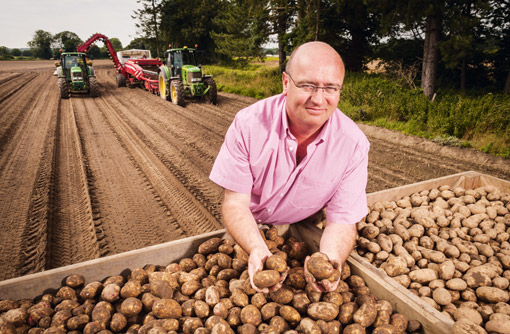Plough away with min-till for better potato growing

Increasing numbers of potato growers are abandoning the plough in favour of a min-till approach to planting potatoes to improve soil structure.
Although not for everyone, there are more growers with suitable soils who could be benefiting from this system, believes Mark Stalham of Cambridge University Farms.
“A few years ago ploughing was the favoured approach because we could weather soils better. But with increasing amounts of tractor power and aggressive machinery, we have lost structure from overworking soils, and organic matter has declined. So our structurally unstable soils are more unstable.”
When excessively cultivated, these sand and silt soils (classified as containing less than 25% clay) break down into smaller and smaller ped (unit of soil structure) sizes.
The reason ploughing is bad for these soils is that even when ploughed under good conditions, soils are prone to different amounts of weathering patterns such as frost and winter rainfall. Too much weathering causes slumping and consolidation resulting in soil that is difficult to dry out the following spring when carrying out secondary cultivations prior to planting, explains Dr Stalham.
A key benefit of non-inversion tillage is soils are left as long as possible before carrying out operations in the spring, thus retaining the natural drainage fissures allowing soil to dry faster.
But that doesn’t mean the plough is obsolete because it is still beneficial once every five to six years. It aids rut levelling, ploughing to different depths and as a drying technique in removing water. It will also help blackgrass control where cereals are included in the rotation and where high levels of debris need incorporating.
However, plough pans will affect rooting, and potatoes are more sensitive to soil compaction than most other arable crops and they are very sensitive to small changes in resistance when growth rates are rapid, says Dr Stalham.
Artificially induced pans from a subsoiled-ploughed interface do not allow adequate depth for maximum take-up of water, he says. “About 80cm would be ideal, but certainly if you can get 40cm of workable soil you will have a pretty good yield potential.”
Non-inversion tillage brings extra 5t/ha
Driven by the need to retain soil structure and reduce compaction, Tony Bambridge of B&C Farming has been using non-inversion tillage to establish 220ha potatoes on his Norfolk farms near Marsham for the past six years.
Working on mostly sandy loam and loamy sand, Mr Bambridge previously ploughed in the autumn. He then moved to spring ploughing, but still encountered problems bringing up wet soil that often slumped or dried rapidly to a clod. So he decided to give non-inversion deep tillage a try.
Stubbles from the preceding winter cereal crop are left until spring, given glyphosate, and then the trailed 4.5m Sumo Trio moves in.
The Sumo has deep ripper tines at 57cm spacing with wings that lift and break the soil, followed by a series of tandem discs that work the soil from side to side creating a crumb structure. At the rear, a large steel compaction roller breaks any clods, explains Mr Bambridge.
“On the lighter sand, one pass with the Sumo and the job is done. On the heaviest soils, we may do two Sumo passes and one pass with a cultivator, a Kongskilde Delta or a Lemken Kristall, that’s the maximum we would do.”
The Sumo passes at two depths, explains Mr Bambridge. The first is 200mm deep and the second depth depends on where he has found any pans. “Often we encounter a plough pan at 300mm, so the final pass would be deeper than that.”
“Then we bed form in the standard way followed by the stone and clod separator, making sure not to go too deep,” he adds.
The main advantage is root fissures and worm holes from two autumns ago are left open to drain freely, he says.
The surface is firm, weatherproof and good to work on, allowing a base dressing of fertiliser to be applied pre-cultivation. There are no ploughed headlands to turn on and the headlands are left until ready to be worked. No wet soil is brought up and pans are taken out.
Speed and cost savings are not the main driver, rather the benefits from improved rooting, he says.
“Our establishment costs haven’t necessarily gone down, but we have improved our establishment and have reduced our unit cost of production because we are getting better yields consistently.”
Improved yield consistency was the absolute key and he estimates it equates to an extra 5t/ha of potato yield.
Keep up with the latest arable news
